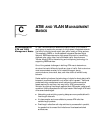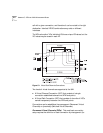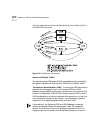
An Introduction to ATM and VLAN Management Basics C-7
In practice, it is not the individual LAN stations that are formed into
VLANs but rather the physical Ethernet LANs, called Ethernet segments,
that are grouped into VLANs. Thus, all stations on an Ethernet segment
will be on the same VLAN. Also, since an Ethernet segment is connected
to the network through an Ethernet port in an edge device, the Ethernet
port itself is sometimes referred to as a member of the VLAN.
Advantages A Virtual LAN, as opposed to an Ethernet LAN, has the great advantage
of being very easy to manage from a central location. Stations are added
or removed from Virtual LANs by software without regard to their
location, there is no need to change physical connections.
The organization of the network into VLANs also reduces congestion
from broadcast frame transmissions. Broadcast frames are now sent only
to members of the same VLAN instead of to all stations on the network.
Virtual LANs also offer network security for their members. Because
transmissions do not normally cross from one VLAN to another, a VLAN
will remain immune to transmission problems or congestion that may
occur in another VLAN in the network.
VLAN Types According to the enabling technology, VLANs are divided into three types:
ATM-based VLANs, tag-based VLANs and protocol-based VLANs. In the
following sections each of these VLAN types is discussed. These Virtual
LAN types are implemented in 3Com products as follows:
These three VLAN types are discussed in the following sections.
Table B-1 VLAN Types in 3Com products
VLAN Type 3Com Product
ATM-based CoreBuilder 7000
CoreBuilder 7X00
SuperStack II Switch 2700
CoreBuilder 5000
SwitchModule
Tag-based SuperStack II Switch
1000/3000
Protocol-based CoreBuilder 2500/6000


















